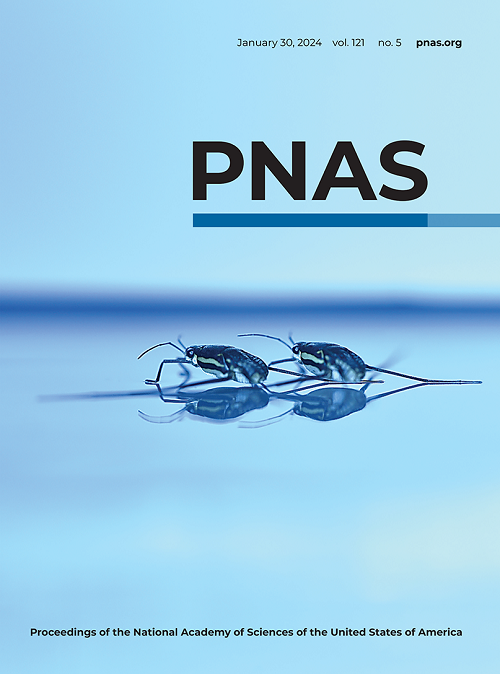兴奋性氨基酸转运蛋白3底物识别的结构基础
IF 9.1
1区 综合性期刊
Q1 MULTIDISCIPLINARY SCIENCES
Proceedings of the National Academy of Sciences of the United States of America
Pub Date : 2025-04-18
DOI:10.1073/pnas.2501627122
引用次数: 0
摘要
兴奋性氨基酸转运蛋白(EAATs)通过离子梯度存在于细胞表面和摄取底物上,包括l -谷氨酸、l -天冬氨酸和d -天冬氨酸。在5种eaat中,EAAT3是唯一能有效运输l -半胱氨酸(一种合成谷胱甘肽的底物)的异构体。最近的研究表明,EAAT3也运输肿瘤代谢物r -2-羟戊二酸(R-2HG)。在这里,我们通过测定EAAT3与不同底物结合的低温电镜(cryo-EM)结构来研究底物识别的结构基础。我们发现l -半胱氨酸以硫酸盐形式与EAAT3结合,EAAT3通过微调配位残基的局部构象来识别不同的底物。然而,使用纯化的人EAAT3,我们没有观察到R-2HG的结合或运输。与l -半胱氨酸结合的EAAT3的成像显示了几种构象状态,包括一个具有半开放门的外向状态和一个断裂的钠结合位点。这些结构表明,在底物结合后,发生了完全的栅极关闭,加上最后一个钠离子的结合。此外,我们观察到不同的底物会影响转运蛋白在完全面向外的构象和通往内向构象的中间封闭状态之间的分布,这表明转运速率依赖于底物。本文章由计算机程序翻译,如有差异,请以英文原文为准。
Structural basis of excitatory amino acid transporter 3 substrate recognition
Excitatory amino acid transporters (EAATs) reside on cell surfaces and uptake substrates, including L-glutamate, L-aspartate, and D-aspartate, using ion gradients. Among five EAATs, EAAT3 is the only isoform that can efficiently transport L-cysteine, a substrate for glutathione synthesis. Recent studies suggest that EAAT3 also transports the oncometabolite R-2-hydroxyglutarate (R-2HG). Here, we examined the structural basis of substrate recognition by determining the cryogenic electron microscopy (cryo-EM) structures of EAAT3 bound to different substrates. We found that L-cysteine binds to EAAT3 in thiolate form, and EAAT3 recognizes different substrates by fine-tuning local conformations of the coordinating residues. However, using purified human EAAT3, we could not observe R-2HG binding or transport. Imaging of EAAT3 bound to L-cysteine revealed several conformational states, including an outward-facing state with a semi-open gate and a disrupted sodium-binding site. These structures demonstrate that the full gate closure, coupled with the binding of the last sodium ion, occurs after substrate binding. Furthermore, we observed that different substrates affect how the transporter distributes between a fully outward-facing conformation and intermediate occluded states on a path to the inward-facing conformation, suggesting that translocation rates are substrate-dependent.
求助全文
通过发布文献求助,成功后即可免费获取论文全文。
去求助
来源期刊
CiteScore
19.00
自引率
0.90%
发文量
3575
审稿时长
2.5 months
期刊介绍:
The Proceedings of the National Academy of Sciences (PNAS), a peer-reviewed journal of the National Academy of Sciences (NAS), serves as an authoritative source for high-impact, original research across the biological, physical, and social sciences. With a global scope, the journal welcomes submissions from researchers worldwide, making it an inclusive platform for advancing scientific knowledge.

 求助内容:
求助内容: 应助结果提醒方式:
应助结果提醒方式:


